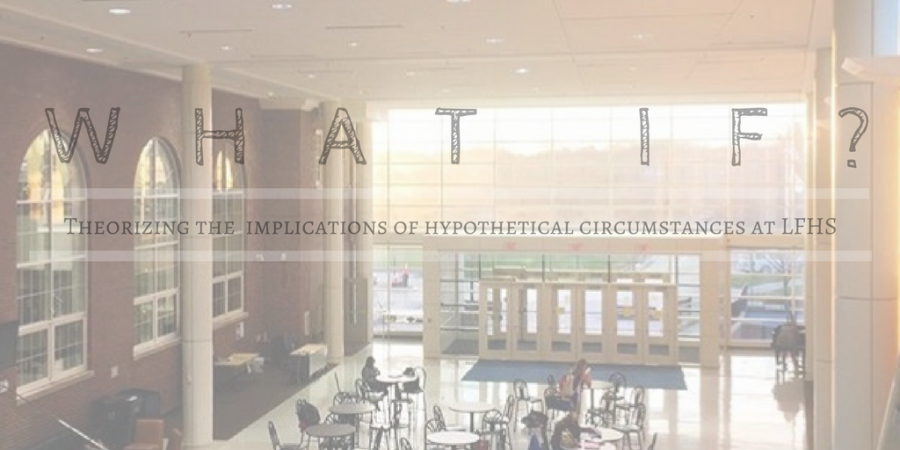In a new feature segment, “What If,” senior Editor-in-Chief Grace Scheidler theorizes the possible implications certain situations and circumstances could have on Lake Forest High School.
Like regular exercise or not snacking after eight at night, our attachment to smartphones is a problem we’re well aware of but not too keen on doing anything to fix it. No matter how many concerned parents or statistically-backed psychologists pen lengthy tomes imploring society– especially teenagers–to unplug, we let it roll off our backs with a slightly uncomfortable shrug. There’s an overwhelming amount of evidence to support the many, many ways our addiction is hurting us, but it appears we don’t care all that much.
In an abstract and somewhat roundabout way, cell phones have filled the void that cigarettes left behind. Instead of the nicotine and cancerous chemicals that affected our bodies physically, the devices we can’t seem to detach ourselves from have wormed themselves into our brains and damaged us psychologically. Twenty years ago teens would thumb their noses at society by lighting up a cigarette and relishing in the cloud of carcinogenic smog despite knowing all that harm it was doing to their lungs.
It may seem an extreme, perhaps hyperbolic, comparison, but that’s only because we gravely underestimate the power these devices hold. As a society we lose it every time the CDC comes out and says something new causes cancer, vehemently swearing off bacon or red meat for a solid week or two. We go to ridiculous extents to incrementally improve our health based on the latest trend–we choke down kale chips and put quinoa on everything, try hot yoga and juice cleanses and detoxes to rid our bodies of various physical toxins. We neglect, however, to think of all of the mental toxins, the depression and anxiety and dysmorphia, that we more than willingly invite into our systems every time we unlock our phones. The amount of studies out there that overwhelmingly support the staggering rise in suicide rates and depression have a very strong link to smartphone use.
But this is old news. We know our dependency on these devices is harming us, and at the same time aren’t motivated enough to do anything about it. If we again take cigarettes as our example, there was evidence way back in the 1940s that they were very harmful to people’s health, though it wasn’t for another twenty years that the Surgeon General finally issued a statement on their dangers. And even then, it took a societal initiative against cigarettes and Big Tobacco to really squash the issue in the United States.
While in some cases all it takes is one person to make a change, it seems that our phone addiction is a problem much bigger than ourselves. As much as the middle-aged writers of those doomsday articles like to espouse the virtues of simply unplugging on occasion, it’s going to take more than that. And while the thought of top-down cellphone control strikes cold fear into the hearts of our technology dependent high school population, it’s interesting to imagine what LFHS would look like technologically pared down.
Logistically, it wouldn’t be all that hard to accomplish. LFHS would hardly be the first school attempting to tackle the phone addiction of their students, and there are multiple ways institutions have gone about combatting this problem as of late. Some have blocked all social media on school networks, and others have utilized newly developed technologies, such as Yondr, which uses wirelessly connected pouches that lock within a certain geographical radius. If students need to access their phones, then, all they have to do is step outside the building. Supposing LFHS adopted one of these methods in spite of all of the pushback (and there would be a lot of pushback), it’s interesting to explore what a phone-free high school would look like. It wasn’t all that long ago that phones were a novelty at this high school. We only have to go back a few graduating classes to get first-hand accounts of a student body stripped of their smartphones.
Now, as far as the obvious case many make for needing their phones on them 24/7 goes, students had been coordinating rides to and from school long before iMessage came around. Most often, students came to school knowing how they were going to get home. And, if they needed to get in touch with their parents during the day, class of 2012 alum Norie Kaufmann recalled, “Usually, I didn’t really need to get in touch with my parents during the day, but if it was something personal that I didn’t want them to forget, I would run to the library during study hall or lunch and send them an email. Or if I forgot something I would go down to the office and call.” She even remembers using a payphone–a payphone! Imagine that!– on more than one occasion. While the iPhones back then didn’t have facial recognition or Uber and Lyft, 2012 was far from the dark ages. In short, that excuse is out the window, but deep down we always knew it was.
If they didn’t rely on them for rides home from school, students then most certainly didn’t need them throughout the day. Our phones have become a way to avoid awkward hallway encounters, to make it from calculus to chemistry without making eye contact.
And while it may seem the only damage being done is the rather frequent collisions between people staring at their screens instead of the path in front of them, all that we’ve lost through this habit is pretty startling. Joseph Santello, a class of 2013 alum, reminisced on his time spent here when he said, “I think the best part of being in the halls at LFHS was everyone was late to their next class because they saw too many friends on their way to their next period.”
Kaufmann–who didn’t get a phone until her senior year, and even then it was a flip phone–added, “Guys used to crowd around the garbage can and talk until the last minute. You would smile at people in the hallway or say hi because it was the only time you saw them. I tried to plan the times I went to my locker so I could maximize the time with my friends.” Think of how much brighter the halls of this high school would seem if we only walked with our heads up instead of bowed over a screen.
And while it may seem normal to pull up Snapchat or refresh Instagram the second we’re not required to be working on something in class, the alums who walked these halls not too long ago tell a different story, perhaps one more memorable and refreshing than the one being told today.
In 2017 it’s customary to see a group of students clustered around a table together without any words being exchanged, except maybe slapped on top of a hastily taken picture with a few emojis to spice it up. Just a few years back, Santello remembers that “No one was ever on their phones unless they were taking videos or pictures with friends. “
In class, too, phones weren’t so divisive as they are now. Teachers describe students with their phones propped against on their computers while working, and it’s common to see the glow of a screen under a desk during a lull in the class.
The funny thing about these apps is that we use them so frequently because we want to be a part of something, and we’re terrified of missing out. And yet, while we chase this elusive feeling of belonging through Snap stories and Facebook posts, we only drive a bigger wedge between ourselves and those around us. We dig our own personal moats through streaks and comments and location tags, and only stop to realize how isolated we are once it’s too late.
The fact that we’ve gotten to this point as a school, however, in so short a time is frightening in itself. At best this piece is hypothetical, because in our hearts we know that we’re not willing and no longer able to make it through our daily lives without our phones.
In all honesty, that should bother us more than it does.













